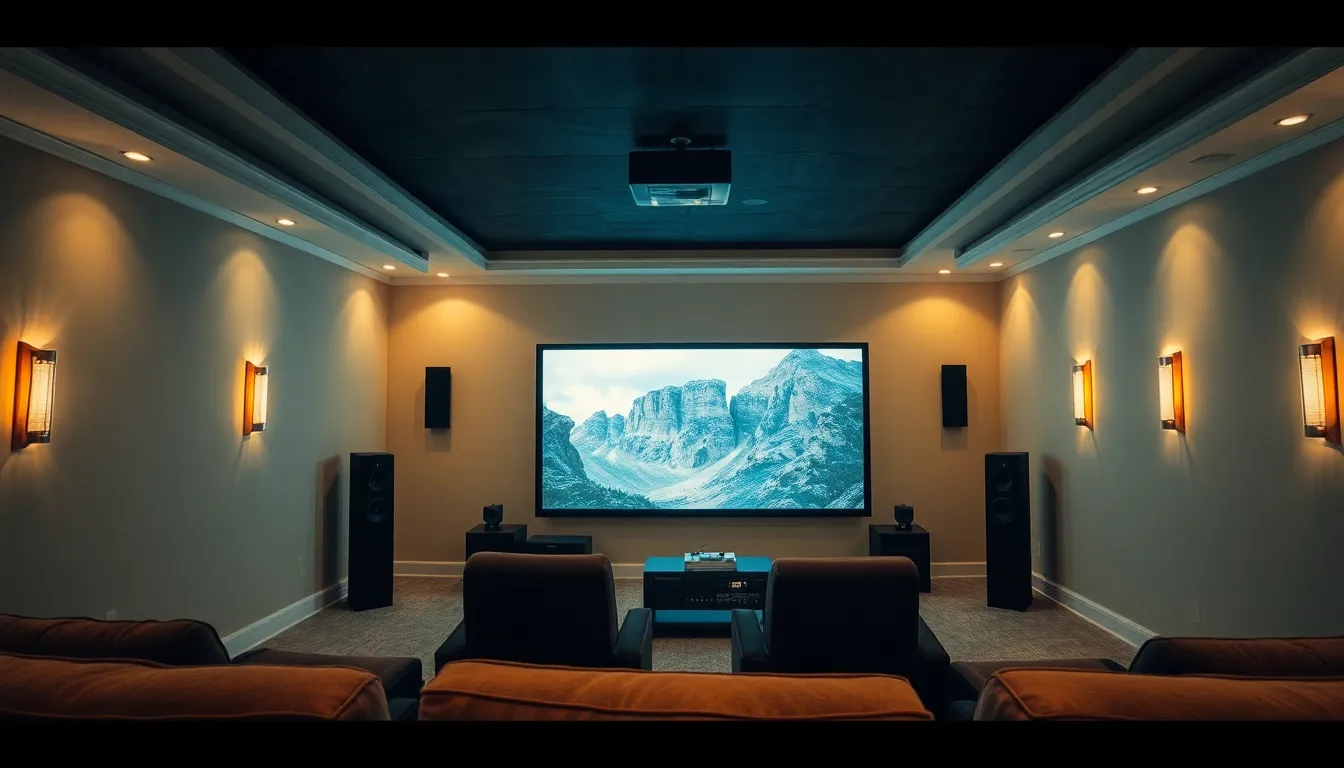Imagine sitting in your living room, popcorn in hand, and suddenly you’re transported to a bustling city street or a serene forest. That’s the magic of theater-grade sound. It’s not just about hearing a movie; it’s about feeling every explosion, every whisper, and every note as if you’re right in the middle of the action.
In a world where sound often takes a backseat to visuals, theater-grade sound steals the show. It transforms ordinary movie nights into unforgettable experiences. With advanced audio technology, even the simplest scene can become a symphony of sensations. So why settle for mediocre sound when you can elevate your entertainment game? Get ready to dive into the world of immersive audio that makes every film feel like an Oscar-winning blockbuster.
Table of Contents
ToggleUnderstanding Theater-Grade Sound
Theater-grade sound refers to the audio quality experienced in a professional cinema setting. This level of sound precision transforms the viewing experience, engaging audiences in a way that home audio systems rarely match.
Definition and Characteristics
Theater-grade sound encompasses advanced audio technologies, providing clarity and depth. It features multi-channel audio systems, like Dolby Atmos and DTS:X, delivering immersive soundscapes. Rich bass notes and crisp high frequencies define its characteristics, allowing sounds to emanate from various directions. A theater-grade system often includes high-quality speakers, subwoofers, and dedicated amplifiers, which enhance performance. Surround sound technology allows for spatial awareness and emotional connection to on-screen action.
Importance in the Cinematic Experience
The importance of theater-grade sound lies in its ability to create a fully immersive environment. Captivating sound enhances storytelling, drawing viewers deeper into the narrative. Viewers react more emotionally when they feel the rumble of an explosion or the subtle whisper of dialogue. Quality audio complements stunning visuals, delivering a complete sensory experience. In commercial theaters, sound has been meticulously engineered to ensure consistency across different viewing environments. An effective audio system elevates the overall impact of film, leaving a lasting impression on audiences.
Components of Theater-Grade Sound

The core elements of theater-grade sound include speakers, audio systems, and acoustic treatments that work in concert to create an immersive experience.
Speakers and Audio Systems
High-quality speakers form the backbone of any theater-grade sound system. These speakers often include multiple channels to distribute sound evenly throughout the theater. In typical setups, surround sound technologies like Dolby Atmos provide three-dimensional audio effects. Some systems utilize subwoofers to add depth by enhancing low-frequency sounds. Depending on the theater size, amplifiers may be required to ensure powerful and clear audio output. Effective audio systems not only amplify sound but also maintain clarity, producing a balanced audio experience that enhances viewers’ engagement with the film.
Acoustic Treatment of Theaters
Acoustic treatment plays a critical role in optimizing sound quality. Soundproofing materials, such as acoustic panels and bass traps, minimize unwanted echoes and vibrations. Many theaters implement these treatments to create a controlled environment that enhances audio clarity. Soft furnishings often absorb excess sound, helping to prevent distortion. Strategic positioning of sound-absorbing elements throughout the space helps in optimizing the auditory experience. Accurate acoustic treatment leads to a noticeable improvement in sound quality, allowing audiences to fully appreciate the layered audio tracks present in modern films.
Comparison with Home Audio Systems
The difference between theater-grade sound and home audio systems becomes evident when comparing their performance and capabilities.
Limitations of Home Sound Systems
Home sound systems often lack the power of theater-grade alternatives. Many home systems provide basic surround sound setups but fail to deliver the full audio experience. Limited speaker configurations restrict sound dispersion and depth. Home systems typically do not feature advanced technologies like Dolby Atmos or DTS:X, which provide immersive soundscapes. Additionally, household acoustics can create challenges, including echoes and poor sound quality. Users may not have access to professional-grade equipment, resulting in a compromise on clarity and richness. These limitations can hinder emotional engagement with film content.
Advantages of Theater-Grade Sound
Theater-grade sound offers a premier audio experience that captivates audiences. Professional sound systems utilize advanced multi-channel technologies to create a rich auditory environment. High-quality speakers and subwoofers work together to produce deep bass and detailed highs, enhancing the movie-watching experience. Acoustic treatments in theaters optimize sound clarity by reducing unfavorable reflections. Engaging sound designs complement stunning visuals, amplifying storytelling and emotional impact. With precise tuning and professional oversight, theater-grade sound provides an unforgettable auditory experience that home systems often can’t replicate.
The Technology Behind Theater-Grade Sound
Theater-grade sound enhances the cinematic experience, immersing viewers through groundbreaking audio technologies.
Dolby Atmos and Surround Sound
Dolby Atmos revolutionizes sound by creating a three-dimensional audio environment. This technology allows sound to move freely around the audience, immersing them in the film. Surround sound systems play a crucial role, delivering audio from multiple channels to achieve depth and clarity. High-quality speakers strategically positioned throughout the theater ensure even sound distribution. Subwoofers further amplify low frequencies, adding richness to explosions and music. Captivating moments in films become more engaging with each sound element precisely placed. Consequently, the atmosphere in theaters transforms into an interactive journey, making viewers feel like they are part of the action.
Innovations in Audio Processing
Audio processing innovations significantly elevate theater-grade sound quality. Advanced algorithms analyze sound waves, optimizing audio fidelity in real time. Spatial audio techniques uniquely position sound elements, enhancing immersion. Real-time mixing allows sound engineers to fine-tune audio for enhanced emotional resonance. Cutting-edge codecs compress data without sacrificing quality, ensuring clarity across diverse sound systems. New developments continuously push the boundaries of realism in sound reproduction. As a result, scenes filled with dialogue, music, and sound effects evolve into multi-layered experiences. The fusion of these technologies contributes to a superior auditory environment that captivates audiences.
Future Trends in Theater-Grade Sound
Advancements in theater-grade sound continually reshape the cinematic landscape. Emerging technologies enhance audio clarity and immersion, providing experiences once reserved for traditional theaters.
Advancements in Sound Technology
Spatial audio technology contributes significantly to enhanced sound experiences. Innovators develop systems that create a three-dimensional audio landscape, placing sounds at precise locations in the environment. Adaptive audio algorithms allow audio mixing in real time, ensuring that every sound element complements the visuals. High-resolution audio formats deliver richer sound quality, elevating cinematic moments to new heights. Companies actively invest in research, focusing on integrating artificial intelligence for improved personalization of sound experiences. Immersive sound formats evolve, with Dolby Atmos leading the charge in providing breathtaking auditory journeys.
The Role of Streaming Services
Streaming services are poised to play a crucial part in the evolution of theater-grade sound. Platforms like Netflix and Disney+ are increasingly adopting high-fidelity audio formats, expanding their libraries to include immersive sound experiences. Significant investments in content production lead to films that utilize advanced audio technologies similar to those found in theaters. As audiences seek immersive home viewing experiences, streaming services respond by offering titles with superior sound quality. Partnerships between streaming services and audio technology companies enhance these advancements, ensuring a consistent delivery of high-level audio direct to viewers’ homes. These services drive demand for better sound systems in home theaters, reshaping consumer expectations for audio quality.
Theater-grade sound is more than just a technical specification; it’s a crucial element that elevates the entire cinematic experience. By embracing advanced audio technologies, viewers can transform their movie nights into immersive journeys that resonate emotionally. As innovations continue to emerge, both in theaters and at home, the demand for high-quality sound will only grow.
Investing in superior audio systems and understanding the importance of acoustic treatments can significantly enhance the enjoyment of films. As streaming services adapt to these trends, audiences can look forward to an ever-evolving landscape of sound that promises to captivate and engage. The future of cinematic audio is bright, and those who prioritize theater-grade sound will undoubtedly reap the rewards.






